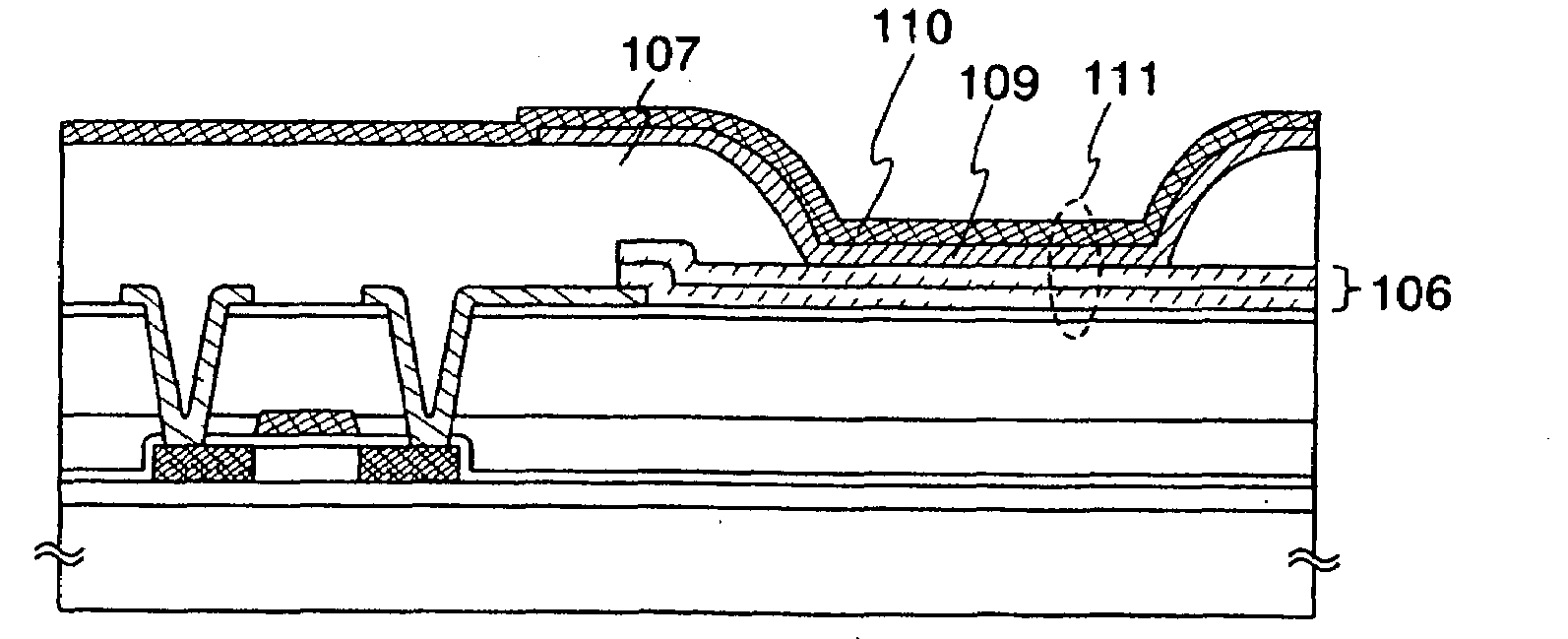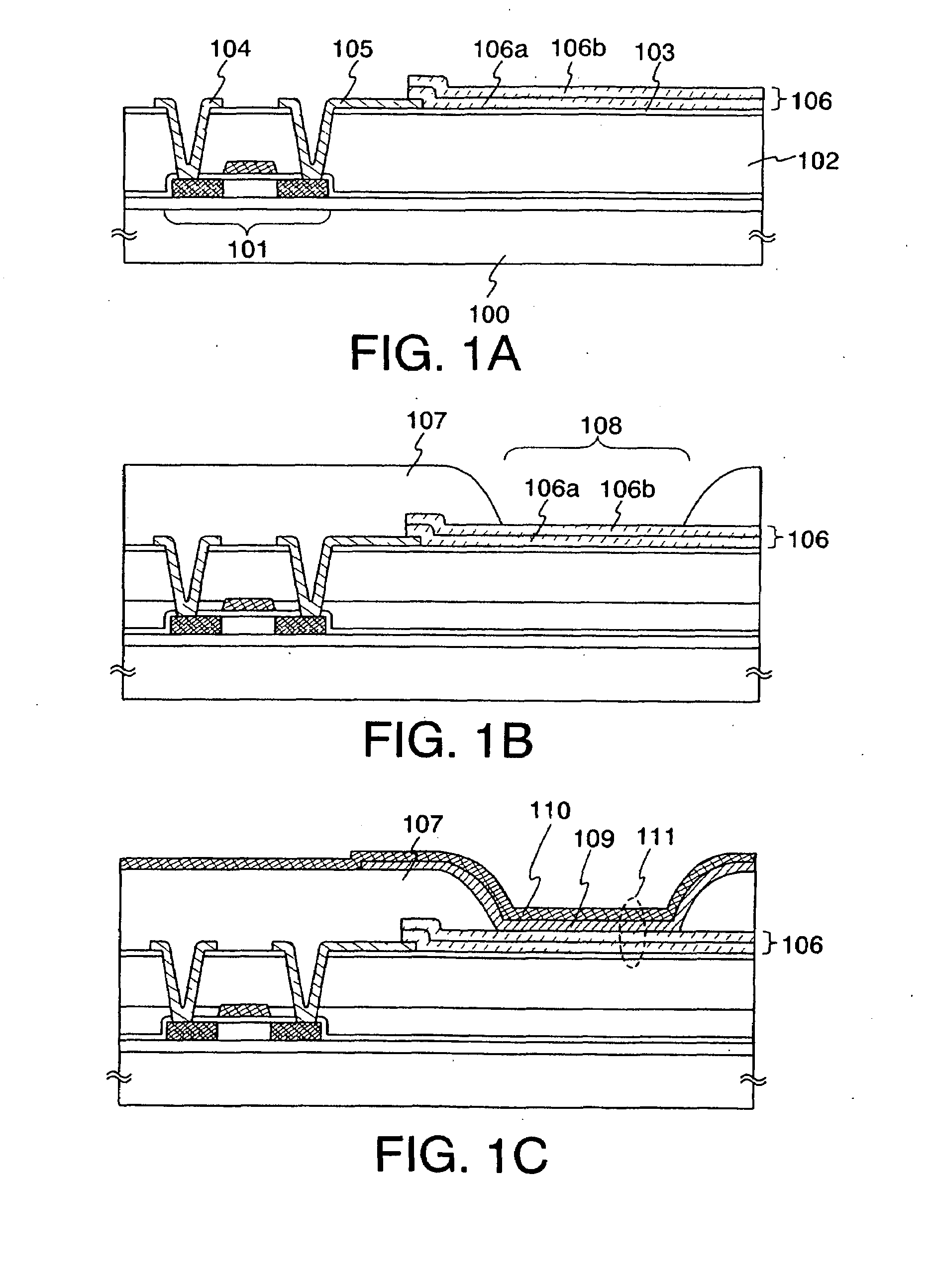Display device and method for manufacturing the same
a technology of a display device and a manufacturing method, which is applied in the field of display devices, can solve the problems of large power consumption, short half-life of luminescence, and insufficient luminance of a conventional light-emitting element, and achieve the effects of reducing current efficiency, reducing the ratio of injected holes to light emission, and improving the effect of injection holes
- Summary
- Abstract
- Description
- Claims
- Application Information
AI Technical Summary
Benefits of technology
Problems solved by technology
Method used
Image
Examples
embodiment 1
[0076]Embodiments of a light-emitting element concerning the present invention are specifically described with reference to FIGS. 7A to 7C, 8A and 8B.
[0077]In this embodiment, the case in which the invention is applied to an active matrix display device, in which a pixel portion and a driver circuit portion are formed over one substrate, is described
[0078]First, a base insulating film 601 is formed on a substrate 600. A glass substrate, a quartz substrate, a silicon substrate, a metal substrate (Al or the like), a stainless substrate, a plastic substrate that has heat resistance withstanding a processing temperature of a manufacturing process, or the like can be used for the substrate 600. Note that when a plastic substrate that is transformed by a processing temperature of a manufacturing process is used, a method for forming TFTs 607, 609, and 610 preliminary over another substrate (a glass substrate, a quartz substrate, or the like) and transferring them to a plastic substrate th...
embodiment 2
[0120]The case to which the present invention is applied in a bottom emission type light-emitting device shown in FIG. 9B is described in Embodiment 1. The case to which the invention is applied in a top emission type light-emitting device shown in FIG. 9A and a dual emission type light-emitting device shown in FIG. 9C is described in this embodiment.
[0121]First, the case of the dual emission type light-emitting device is described. In this case and Embodiment 1 alike, as a material of a hole injection electrode, conductive transparent oxide layer, containing silicon or silicon oxide, such as ITO, zinc oxide (ZnO), or IZO can be used by laminating. It is preferable to use ITSO containing silicon or silicon oxide of which concentration ranges from 0% to 20 atomic % and further to use a lamination of an ITSO layer containing silicon or silicon oxide of a low concentration (more preferably, from 1 atomic % to 6 atomic %) and an ITSO layer containing silicon or silicon oxide of a high c...
embodiment 3
[0126]The case applying the present invention to an active matrix type light-emitting device having a reverse stagger structure is described in this embodiment with reference to FIGS. 10A-10D and 11.
[0127]A conductive film for forming a gate electrode and a gate wiring (a scanning line) is formed over a substrate 1100 made from the same material as that of Embodiment 1. A metal material such as chromium, molybdenum, titanium, tantalum, tungsten, or aluminum or the alloy material thereof is used for the conductive film. This conductive film can be formed by a sputtering method and a vapor deposition method.
[0128]A conductive film is etched to form gate electrodes 1101 and 1102. Since a first semiconductor film and a wiring layer are formed over the gate electrodes 1101 and 1102, it is preferable that the conductive film is processed so that the edge thereof has a taper shape. When the conductive film is formed from a material containing aluminum as the main component, the surface may...
PUM
| Property | Measurement | Unit |
|---|---|---|
| temperatures | aaaaa | aaaaa |
| curvature radius | aaaaa | aaaaa |
| temperatures | aaaaa | aaaaa |
Abstract
Description
Claims
Application Information
 Login to View More
Login to View More - R&D
- Intellectual Property
- Life Sciences
- Materials
- Tech Scout
- Unparalleled Data Quality
- Higher Quality Content
- 60% Fewer Hallucinations
Browse by: Latest US Patents, China's latest patents, Technical Efficacy Thesaurus, Application Domain, Technology Topic, Popular Technical Reports.
© 2025 PatSnap. All rights reserved.Legal|Privacy policy|Modern Slavery Act Transparency Statement|Sitemap|About US| Contact US: help@patsnap.com



